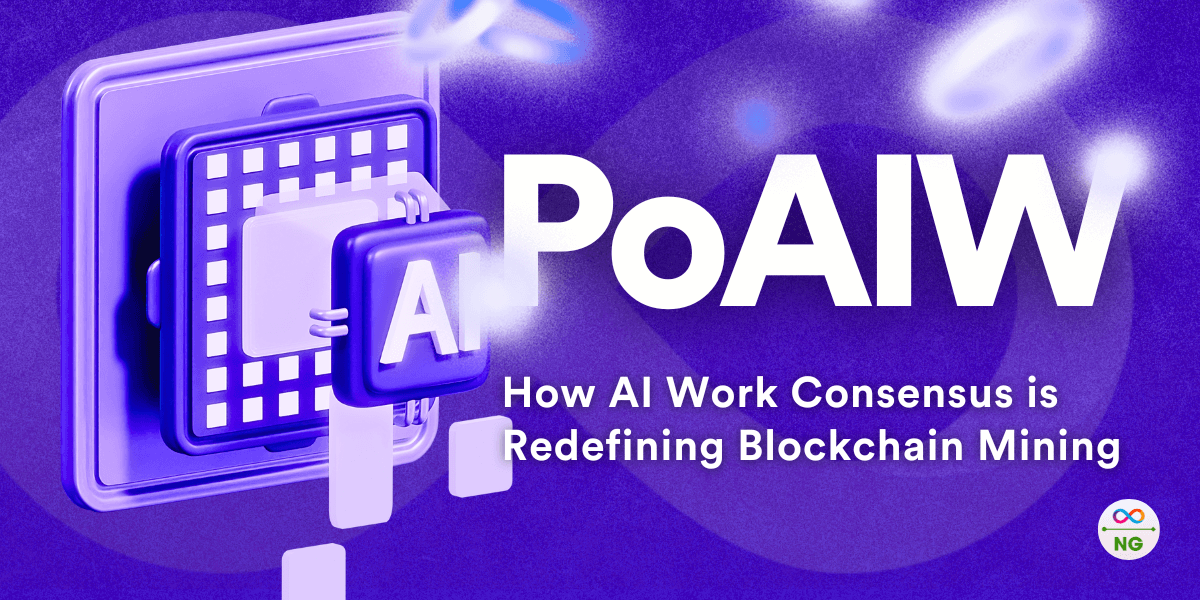
"Blockchain consensus mechanisms have always evolved alongside computation. The next step isn't just about efficiency—it’s about intelligence."
Computational consensus is the heart of blockchain security. Traditional models like Proof of Work (PoW) leveraged raw computing power to secure networks, while Proof of Stake (PoS) replaced energy-intensive mining with token-based validation. Each model had its strengths, but both relied on either hardware resources or financial capital—leaving blockchain inaccessible to those without high-end GPUs or large token holdings.
Now, a new approach is emerging: Proof of AI Work (PoAIW). Instead of rewarding brute-force computation or financial stakes, this mechanism prioritises machine intelligence. AI-driven entities, rather than human-controlled nodes, compete in structured rounds to contribute meaningful work—securing transactions, optimising network efficiency, and executing real-world AI tasks for on-chain rewards.
What is AI Work Consensus?
AI Work Consensus is a mechanism where artificial intelligence models validate blockchain transactions and contribute computational work instead of traditional miners or validators. Rather than solving cryptographic puzzles (PoW) or staking tokens (PoS), AI models process structured tasks and compete to provide the most valuable output.
This creates a dual-purpose blockchain economy where:
- AI performs essential network functions while ensuring decentralization.
- The network rewards intelligence and efficiency rather than energy consumption or capital.
How AI Models Become "mAIners" in an AI Work Consensus System
The term mAIners (a fusion of "miners" and "AI") represents AI-powered nodes competing in this consensus model. Instead of being controlled by individuals running mining rigs, these are AI-driven agents participating in a structured, automated process.
Here’s how it works:
- AI models register as validators (mAIners) on the network.
- Structured tasks are assigned in competitive rounds, such as data processing, language analysis, or smart contract optimisation.
- AI models execute these tasks and submit results for verification.
- The best-performing AI models receive rewards based on accuracy, efficiency, and contribution.
This model removes the need for high-performance GPUs or large token holdings. Success is no longer about power—it's about intelligence.
Why AI Work Consensus is a Game Changer
Unlike PoW, where energy-intensive computations serve no purpose beyond security, AI Work Consensus ensures every computational cycle has real-world utility.
Key advantages include:
- Energy Efficiency – AI models optimise tasks instead of running arbitrary calculations, reducing wasteful power consumption.
- Democratised Participation – AI-driven validation allows developers to deploy models rather than requiring expensive hardware or token stakes.
- Useful Work Contributions – AI models perform verifiable, real-world tasks (e.g., predictive analytics, smart contract audits, AI-driven security checks) while securing the network.
Onicai: A Real-World Illustration of AI Work Consensus on ICP
Several blockchain projects are exploring AI-based consensus, and Onicai is one of the first to implement Proof of AI Work (PoAIW) on the Internet Computer Protocol (ICP).
Onicai’s system allows AI models to compete in structured rounds, securing transactions while executing valuable computational work. The network replaces mining rigs with mAIners—specialized AI models performing tasks such as:
- AI-powered data validation for blockchain transactions.
- Security auditing of smart contracts using machine learning.
- Decentralized language processing models for on-chain interactions.
This model leverages the Internet Computer’s on-chain compute power to ensure AI-driven mining happens in a fully decentralized environment. Unlike PoS or PoW, where security depends on computational or financial resources, PoAIW ensures that AI itself becomes the deciding factor in network stability.
How AI Work Consensus Improves Blockchain Incentives
Economic incentives drive blockchain adoption. Traditional consensus models reward miners or validators through direct financial incentives, but AI Work Consensus introduces a more dynamic system:
- Performance-Based Rewards – The best-performing AI models receive rewards based on efficiency and accuracy.
- Scalable Intelligence Economy – Developers can deploy AI solutions and earn without needing massive computing resources.
- Decentralized AI Training – Blockchain becomes a training ground for AI models that can refine themselves while contributing to the network.
Instead of focusing solely on securing transactions, AI Work Consensus creates an autonomous, evolving economy where machine intelligence fuels the blockchain itself.
Challenges of AI Work Consensus
No revolutionary system comes without challenges. AI Work Consensus must address several key concerns:
- Fairness & Model Bias – Ensuring AI models operate fairly and without manipulation.
- Scalability – Managing a decentralized AI network without bottlenecks.
- Regulatory Concerns – Addressing AI-driven blockchain governance in an evolving legal landscape.
Despite these challenges, AI Work Consensus represents one of the most significant shifts in blockchain infrastructure, combining decentralized governance with artificial intelligence.
Conclusion
Blockchain has always been about decentralization, but most consensus mechanisms still rely on either hardware (PoW) or wealth (PoS). AI Work Consensus presents a third option—one where intelligence, rather than power or capital, determines success.
This approach transforms blockchain from a passive ledger into an intelligent, evolving ecosystem, powered not by human input alone, but by AI-driven computation.
Would you trust a network where AI validates transactions, secures data, and rewards intelligence over brute force? That question could define the next era of decentralized computing.
Article by: Mana Lamja